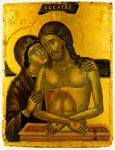|
|
| Portable Icons |
16th c., 1st half Iviron Monastery Wood, egg tempera, 23.5 x 18 cm Cretan School |
|

|
Christ is portrayed as the Man of Sorrows, lifeless and naked in a red sarcophagus, with his hands crossed before his abdomen. On his right, the Virgin embraces him with controlled grief. The arms of the cross can be made out behind the two figures. Two inscriptions in red lettering survive on the gold field: 'Jesus Christ' and 'Mother of God'; and on a panel on the cross: 'The King'. This subject, which is very well known in fifteenth- and sixteenth-century western painting, was introduced into the religious iconography of the Orthodox east by an icon now in St Petersburg painted by Nikolaos Tzafouris in the last quarter of the fifteenth century (Chatzidakis 1974 (2), pp. 183-5, pl. ΙΕ΄.1). The Iviron Christ in fact closely reproduces the iconographical type of Tzafouris's icon of the Man of Sorrows now in Vienna (before the end of the fifteenth century), as also of another icon of the same subject painted in the early sixteenth century and now on Patmos (Chatzidakis 1974 (2), pl. ΙΔ΄.1. Chatzidakis 1977, no. 28, pl. 91). Typologically and stylistically, the anonymous artist adopts facial types and artistic techniques of the Cretan School, which trace their origins to late Palaeologan painting (Xyngopoulos 1956, pls. 7.1, 7.2). Specifically, the facial types of Christ and the Virgin, as also the modelling of the faces, with the triangular shadows under the eyes, the brown shading softly blending into the pink of the flesh, and the supple linear highlights, have parallels in a late fifteenth-century icon of the Crucifixion in the Church of the Virgin in Lithines, Crete (Eikones, no. 145), and also in the paintings of Theophanis the Cretan (Chatzidakis 1969-70, figs. 18-20). The same technique is seen on an early sixteenth-century processional cross on Patmos with the crucified Christ painted on the main face (Chatzidakis 1977, no. 32, pl. 90). In view of what has been said above, this writer believes that the icon, which obviously has connections with the Cretan School, may be dated to the beginning of the sixteenth century, though it may very well be associated with the artistic activity of Theophanis the Cretan on Mount Athos.
| |
|
Bibliography: Chatzidakis 1953, p. 22, pl. XV.11. Tsigaridas 1992, p. 164, fig. 7.
| ||
| E.N.T. | ||
| Index of exhibits of Monastery of Iviron 16th century |
||
Reference address : https://www.elpenor.org/athos/en/e218ab39.asp